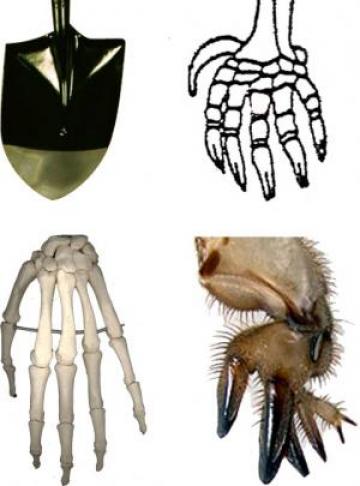Summary of problems:
Similarity of the structure of mole cricket forelimbs and the paws of a mole does not, in any sense, suggest homology between those structures. No one has ever suggested such a thing. Homology consists of more than similarity of shape, but similarity of underlying structures.
Full discussion:
It is worth noting in passing that only a few pages after complaining about the presentation of different fossil skulls without showing the different sizes of the skulls, every graphic in this chapter compares organisms and structures of very different sizes without any indication of the relevant scale. Human arms are 3 feet long, horse legs are generally around 5 feet long, bat wings are a foot or two long, and a whale flipper can stretch close to ten feet long (fig. 2:1). Mammal eyes are generally between half an inch and an inch deep, insect eyes are fractions of an inch across, and cephalopod eyes can be a foot and a half wide (fig 2:2). Ichthyosaurs were 3-6 feet long while the baleen whales EE compares them to are 40-50 feet long (fig. 2:3). A mole cricket is an inch long, a mole is closer to 8 inches long (fig. 2:4). This point is minor, but emphasizes the inconsistent approach Explore Evolution takes to its subject.
EE's attempt to claim some deep meaning for the similarities between the mole cricket's forelimbs and mole hands would be entertaining if it were not obvious that EE intends that comparison to be taken seriously. EE wonders:
are there some similarities not due to common ancestry? Surprisingly, nearly all biologists say there are. The flippers of a whale and an ichthyosaur have very similar shapes, even though the whale is a mammal and the ichthyosaur was a reptile. The forelimb of a mole cricket is very similar to a mole's forelimb, even though the mole is a mammal and the mole cricket is an insect.
Even biologists who take a monophyletic view of life's history will tell you that the similarity we see in these structures is not the result of common ancestry. They contend that the last common ancestor of these creatures did not possess the similar structure. In other words, the similar structures arose separately on independent lines of descent.EE, p. 46-48
 Spade or hand?: A shovel, a mole paw, a human hand, and a mole cricket forelimb. Which structures are homologous? Which share functional constraints?
Spade or hand?: A shovel, a mole paw, a human hand, and a mole cricket forelimb. Which structures are homologous? Which share functional constraints? It is not clear why anyone, let alone textbook authors, should be surprised that certain basic shapes recur in nature. The shape of a flipper or a wing or a digging implement is constrained not only by the evolutionary history of that structure, but by the nature of the work it is used to do. Limbs shaped more like a flipper tend to make animals better swimmers, whether they are birds (penguins), mammals (whales), or reptiles (ichthyosaurs). The question a biologist asks in assessing homology is not whether the shape of a structure is similar, but whether the composition and developmental origins of the structure are homologous. On that front, there is simply no basis for claiming any homology between cricket limbs and mole paws, any more than there is a homology between mole paws and a spade. An examination of the anatomy of a mole paw, cricket limb, shovel, and a human hand makes it clear why the similarities in the basic outline of three of these structures is less evolutionarily significant than the clear anatomical similarities between the human hand and the mole paw.
This example is so obvious an instance of functional constraints creating similarities in structures that biologists have been using it to illustrate this point since at least the 1950s. Michael Novikoff wrote in 1953:
the concept of analogy includes two different categories of phenomena. One clearly corresponds to the accepted definition of this term, according to which analogous forms are understood to be those that have been secondarily acquired by animals or plants in adaptation to similar environmental situations. As an appropriate example of such an analogy one may cite the front appendages of such widely different animals as the mole, Talpa europaea, and the mole cricket, Gryllotalpa vulgaris. The ends of the front legs of both the mammalian burrower and the insect burrower are shovel-like, well suited to digging underground. Another example, the acquisition of a snow-white fur or plumage by various animals of the northern regions, may be mentioned. This analogy is concerned with a purely physiological phenomenon and is therefore in contrast to homology, which is a morphological or phylogenetic phenomenon.Michael M. Novikoff (1953) "Regularity of Form in Organisms" Systematic Zoology 2(2):57-62.
It is not the least surprising that certain shapes recur in nature, coming from disparate origins. The surprise expressed by Explore Evolution is truly disappointing. A textbook is not supposed to encourage confusion among students, but to clarify misconceptions. EE's befuddled efforts to cast doubt on evolution merely reflect the authors' own misunderstandings; misunderstandings that no school board nor teacher should wish its students to perpetuate.
